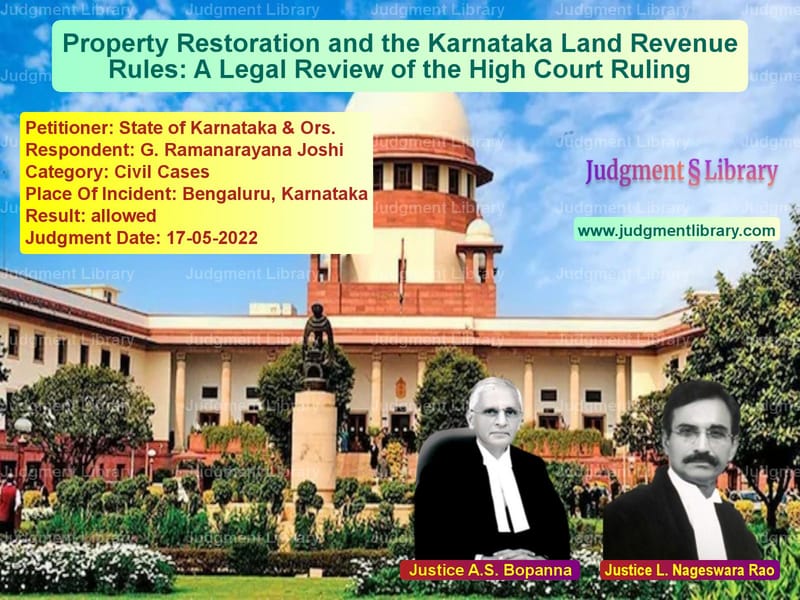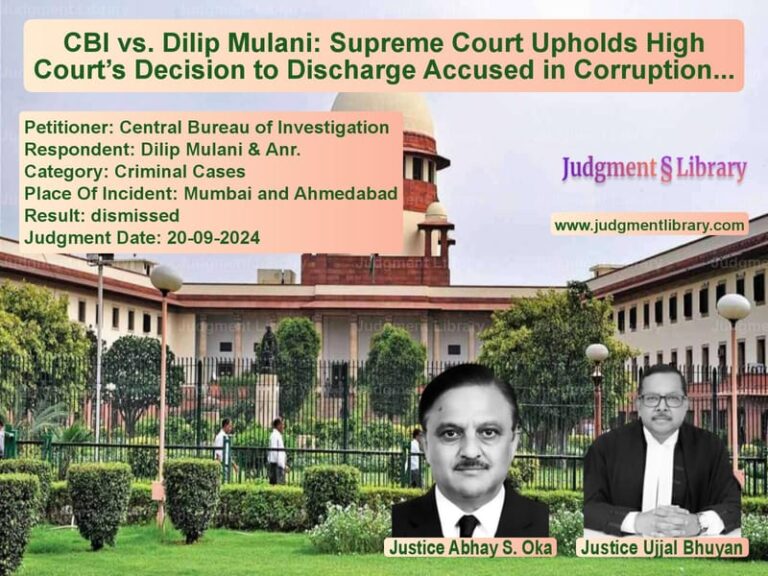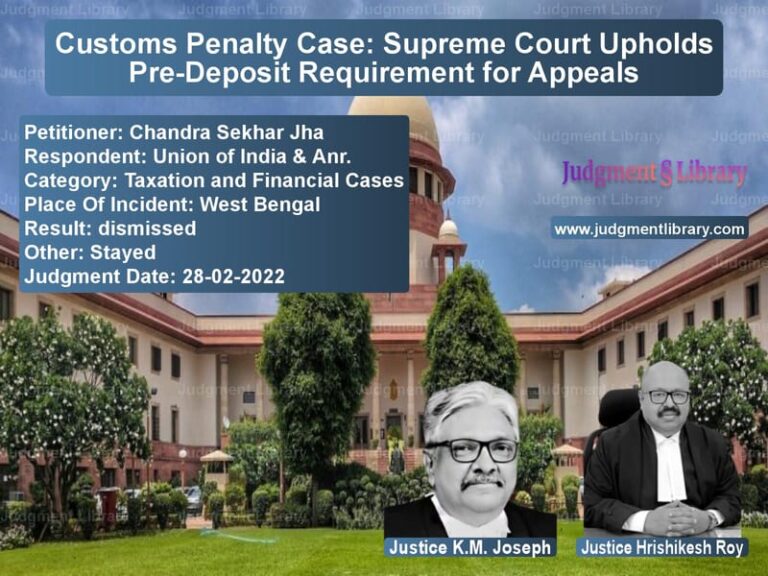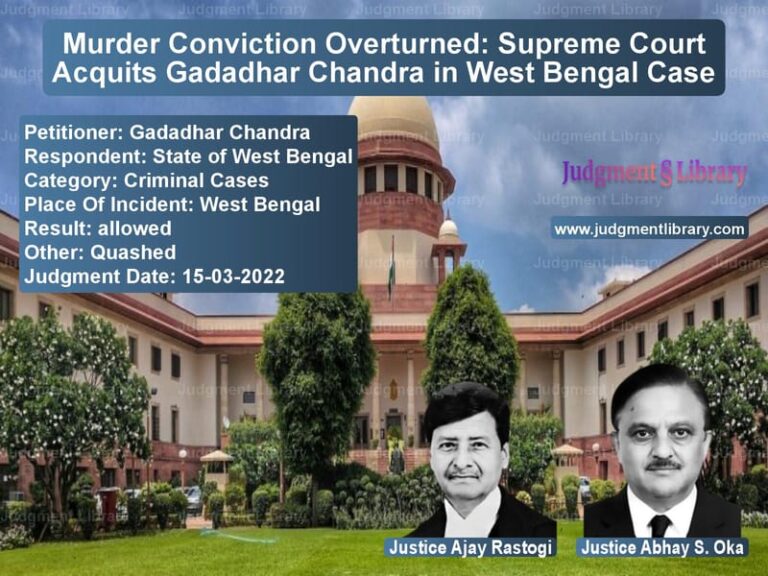Property Restoration and the Karnataka Land Revenue Rules: A Legal Review of the High Court Ruling
This case concerns a dispute over the restoration of forfeited land, specifically regarding the property of G. Ramanarayana Joshi, which was allegedly transferred to the Forest Department by the Government of Karnataka. The appellant, the State of Karnataka, contested the High Court’s decision to allow the restoration of the property to the respondent, claiming that the land had been disposed of and therefore could not be restored. The issue revolves around the application of Rule 119 of the Karnataka Land Revenue Rules, 1966, which governs the restoration of forfeited land and the procedure for such restoration.
Petitioner’s Arguments
The appellant, represented by Mr. Nikhil Goel, the Additional Advocate General, argued that the respondent’s claim for the restoration of the property was invalid due to the fact that the property had been forfeited for non-payment of land revenue as far back as 1892. The appellant further contended that, as per the amended sub-rule (2) of Rule 119, the property in question was not eligible for restoration because it had been transferred to the Forest Department for the creation of a land bank in 1994. The appellant emphasized that the land had already been disposed of, and as such, the provisions for restoration under Rule 119 could not be applied.
The appellant cited the Government Order dated 20.07.1994, which transferred a large area of land, including the property in question, to the Forest Department. The appellant argued that this transfer rendered the property ineligible for restoration under the Karnataka Land Revenue Rules, and the respondent’s request for restoration should be denied. The appellant further pointed out that the respondent had not taken timely action to contest the transfer and had failed to establish that the property was still in the possession of the respondent or their predecessors.
Respondent’s Arguments
The respondent, represented by Mr. Raghavendra S. Srivatsa, contested the appellant’s claims and argued that the property in question remained in the possession of the respondent and their ancestors, despite the forfeiture of the land in 1892. The respondent contended that the land had been purchased by their ancestors in 1887 and that, despite the forfeiture, the family had continued to occupy and cultivate the land. The respondent emphasized that the property had never been formally transferred to any other party, and the family had maintained possession over the years.
The respondent further argued that the amendment to sub-rule (2) of Rule 119, which came into effect in 2000, provided a window for the restoration of such forfeited land, provided the application for restoration was filed within one year. The respondent filed the application for restoration within the prescribed time frame and had complied with all procedural requirements. The respondent also pointed out that the Tehsildar and Assistant Commissioner had confirmed that the land was still in their possession, thus fulfilling the requirement for restoration under Rule 119.
Additionally, the respondent argued that the Government Order of 1994 did not legally dispossess the family, as the land was transferred to the Forest Department only for the purpose of creating a land bank. The respondent contended that the Forest Department did not acquire ownership of the land but only became the custodian, and the land remained under the control of the Revenue Department. The respondent thus claimed that they were still entitled to the restoration of the land under the rules.
Court’s Analysis and Conclusion
The Supreme Court examined the arguments presented by both parties, focusing on the applicability of Rule 119 of the Karnataka Land Revenue Rules, 1966, and the Government Order dated 20.07.1994. The Court noted that the respondent had filed the application for restoration within the one-year period prescribed by the amendment to Rule 119. The Court also observed that the land had been forfeited due to non-payment of land revenue, and while the Government had transferred the land to the Forest Department in 1994, the transfer was not a formal sale but a reclassification of the land for the purpose of creating a land bank.
The Court emphasized that the Government Order did not dispossess the respondent or their family from the land, and the property remained in the possession of the family, as confirmed by the reports of the Tehsildar and Assistant Commissioner. The Court concluded that the respondent had a legitimate claim to the restoration of the land under the amended provisions of Rule 119, as they continued to be in possession of the property despite the forfeiture and transfer to the Forest Department.
The Court further considered the procedural aspects of the case, noting that the Deputy Commissioner had initially rejected the respondent’s application for restoration. However, the Court found that the respondent had complied with all the necessary requirements for the restoration of the land and that the application should have been granted. The Court also noted that the previous rulings and findings in the matter had not been adequately considered by the authorities, leading to an improper rejection of the restoration claim.
Final Decision
The Supreme Court ruled in favor of the respondent, quashing the High Court’s decision and restoring the land to the respondent. The Court held that the respondent was entitled to the restoration of the forfeited land under Rule 119 of the Karnataka Land Revenue Rules, 1966. The Court emphasized that the respondent had fulfilled all legal requirements and had remained in possession of the property, making them eligible for the restoration. The appeal was allowed, and the judgment of the High Court was set aside.
Petitioner Name: State of Karnataka & Ors..Respondent Name: G. Ramanarayana Joshi.Judgment By: Justice A.S. Bopanna, Justice L. Nageswara Rao.Place Of Incident: Bengaluru, Karnataka.Judgment Date: 17-05-2022.
Don’t miss out on the full details! Download the complete judgment in PDF format below and gain valuable insights instantly!
Download Judgment: state-of-karnataka-&-vs-g.-ramanarayana-josh-supreme-court-of-india-judgment-dated-17-05-2022.pdf
Directly Download Judgment: Directly download this Judgment
See all petitions in Property Disputes
See all petitions in Contract Disputes
See all petitions in Landlord-Tenant Disputes
See all petitions in Judgment by A. S. Bopanna
See all petitions in Judgment by L. Nageswara Rao
See all petitions in allowed
See all petitions in supreme court of India judgments May 2022
See all petitions in 2022 judgments
See all posts in Civil Cases Category
See all allowed petitions in Civil Cases Category
See all Dismissed petitions in Civil Cases Category
See all partially allowed petitions in Civil Cases Category







